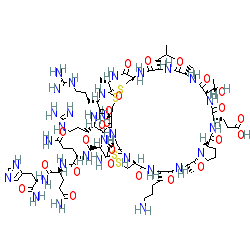GtoPdb is requesting financial support from commercial users. Please see our sustainability page for more information.
|
Compound class:
Peptide
Comment: Expressed by the venom gland of the honeybee (Apis mellifera)
Ligand Activity Visualisation ChartsThese are box plot that provide a unique visualisation, summarising all the activity data for a ligand taken from ChEMBL and GtoPdb across multiple targets and species. Click on a plot to see the median, interquartile range, low and high data points. A value of zero indicates that no data are available. A separate chart is created for each target, and where possible the algorithm tries to merge ChEMBL and GtoPdb targets by matching them on name and UniProt accession, for each available species. However, please note that inconsistency in naming of targets may lead to data for the same target being reported across multiple charts. ✖ |
|
|||||||||||||||||
| References |
|
1. Barfod ET, Moore AL, Lidofsky SD. (2001)
Cloning and functional expression of a liver isoform of the small conductance Ca2+-activated K+ channel SK3. Am J Physiol, Cell Physiol, 280 (4): C836-42. [PMID:11245600] |
|
2. Church TW, Weatherall KL, Corrêa SA, Prole DL, Brown JT, Marrion NV. (2015)
Preferential assembly of heteromeric small conductance calcium-activated potassium channels. Eur J Neurosci, 41 (3): 305-15. [PMID:25421315] |
|
3. Hosseini R, Benton DC, Dunn PM, Jenkinson DH, Moss GW. (2001)
SK3 is an important component of K(+) channels mediating the afterhyperpolarization in cultured rat SCG neurones. J Physiol (Lond.), 535 (Pt 2): 323-34. [PMID:11533126] |
|
4. Jäger H, Adelman JP, Grissmer S. (2000)
SK2 encodes the apamin-sensitive Ca(2+)-activated K(+) channels in the human leukemic T cell line, Jurkat. FEBS Lett, 469 (2-3): 196-202. [PMID:10713270] |
|
5. Kohler M, Hirschberg B, Bond CT, Kinzie JM, Marrion NV, Maylie J, Adelman JP. (1996)
Small-conductance, calcium-activated potassium channels from mammalian brain. Science, 273 (5282): 1709-14. [PMID:8781233] |
|
6. Kuzmenkov AI, Peigneur S, Nasburg JA, Mineev KS, Nikolaev MV, Pinheiro-Junior EL, Arseniev AS, Wulff H, Tytgat J, Vassilevski AA. (2022)
Apamin structure and pharmacology revisited. Front Pharmacol, 13: 977440. [PMID:36188602] |
|
7. Shah M, Haylett DG. (2000)
The pharmacology of hSK1 Ca2+-activated K+ channels expressed in mammalian cell lines. Br J Pharmacol, 129 (4): 627-30. [PMID:10683185] |
|
8. Stocker M, Hirzel K, D'hoedt D, Pedarzani P. (2004)
Matching molecules to function: neuronal Ca2+-activated K+ channels and afterhyperpolarizations. Toxicon, 43 (8): 933-49. [PMID:15208027] |
|
9. Strøbaek D, Jørgensen TD, Christophersen P, Ahring PK, Olesen SP. (2000)
Pharmacological characterization of small-conductance Ca(2+)-activated K(+) channels stably expressed in HEK 293 cells. Br J Pharmacol, 129 (5): 991-9. [PMID:10696100] |
|
10. Weatherall KL, Goodchild SJ, Jane DE, Marrion NV. (2010)
Small conductance calcium-activated potassium channels: from structure to function. Prog Neurobiol, 91 (3): 242-55. [PMID:20359520] |







